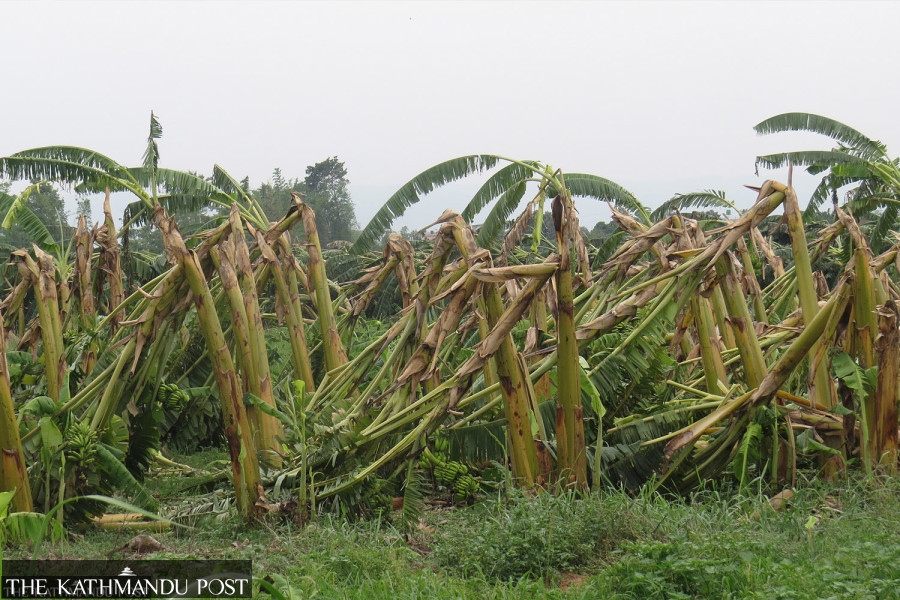Money
Banana farmers upset over delay in settlement of insurance claims
Banana farmers from Chitwan are in Kathmandu to remind the government why they are not getting the insured payout.
Ramesh Kumar Paudel
Time is ripe for banana farmers' business. Having sold Malbhog bananas, a highly popular variety, farmers are harvesting William's hybrid and Grand Naine (G9).
But, despite their busy time, farmers of the cash crop are compelled to travel to Kathmandu just to ask the government why they are not getting the insurance amount for the losses they incurred in May.
Since Saturday, farmers have been in Kathmandu to claim insurance amounts.
On May 31, strong winds over two days destroyed bananas planted on a large area of land in eastern Chitwan.
Madhav Ghimire, president of the Chitwan Banana Producers Association, said the storm damaged bananas worth Rs150 million.
The farmers’ association claimed it was the worst loss they had ever borne.
"Officials from the insurance companies came to the affected areas and made a report. But it has been months, and they have not released the insurance payout."
While banana farmers have insured their crops and have not received the claim, insurance companies are hesitant to accept premiums for the new crop. Most of the farmers in Chitwan said they are in a dilemma.
"We are in Kathmandu to settle these two crucial issues," said Bishnu Hari Panta, a former president of the association. "We met with the agriculture minister and the secretary on Sunday."
"If farmers remain in the dilemma, how can they grow [the crop]?"
He said that despite paying the insurance, farmers are not getting the compensation. “And if the companies are hesitant to insure the crop, it will put every farmer on the brink.”
Experts say climate change is making storms more intense and devastating. Storms, hailstorms, droughts, and floods are also increasing in Nepal and are considered major climate-related disasters.
According to the National Climate Change Survey 2022, released by the National Statistics Office, the economic losses on-farm and off-farm sectors in the last five years, excluding significant infrastructure damages, amounted to Rs415.44 billion.
The survey report said that drought had been reported as the major disaster, affecting 65.4 percent of households, followed by diseases and insects at 54.3 percent, storms at 46.2 percent, hailstorms at 32.6 percent, floods at 28.5 percent, cold waves at 21.7 percent, landslides at 21.5 percent, and inundation at 17.5 percent.
Farmers in Chitwan lament the government’s policy on insurance.
On Monday, the group of farmers also met with officials of some insurance companies and the Nepal Insurance Authority at the agriculture minister's quarters.
Ghannath Mahato, the association's immediate past president, has a banana farm in Jagatpur that was less affected by May’s storm. His insurance term, too, ended in mid-July or by the end of the last fiscal year, and he needs to renew it for the new fiscal year.
"But insurance companies are reluctant to insure my crop," said Mahato, who is a part of the delegation.
Since March 14, non-life insurance companies have stopped settling claims for insured farm products after failing to receive government premium subsidies.
“I am worried. If the storm, which is frequent in Chitwan, damages my crop, I will be at a huge loss,” he said. “This is the time to spend in the field, but we are knocking on the agriculture minister's door with our grievances."
In Chitwan, banana plantation covers 3,500 bigha (2,370 hectares). Most of the plantations are in the eastern part of Chitwan.
According to the association president Ghimire, they usually get insurance payout late.
“Last time, it took 13 months to get the insurance. We are not sure how long it may take for this one."
Crop insurance was introduced in Nepal with much fanfare. The government formulated directives for crop and livestock insurance in January 2013.
Under the scheme, the government provided a 50 percent subsidy on the premium in the first year and raised it to 75 percent in the second year.
The premium subsidy was again reduced to 50 percent and raised to 80 percent in 2021. Currently, the government bears 80 percent of the insurance premiums, and the farmers bear the rest.
When the insurance scheme started in 2013, there were 802 claims. In the previous fiscal year, the annual claims reached 36,000.
Insurance companies say the government has not released the insurance premium amount, so they cannot settle it.
"The agriculture minister has assured us we will settle the issue as soon as possible," said Panta.
The premium for banana crops has been fixed at Rs275 per tree. In case of loss, the insurance company pays up to 90 percent of it.
"If a farmer planted Malbhog bananas on a biga of land, the insurance premium costs Rs30,339," said Panta. "The farmers have to pay Rs6,070, and the government pays Rs24,269."




 10.12°C Kathmandu
10.12°C Kathmandu1.jpg)














